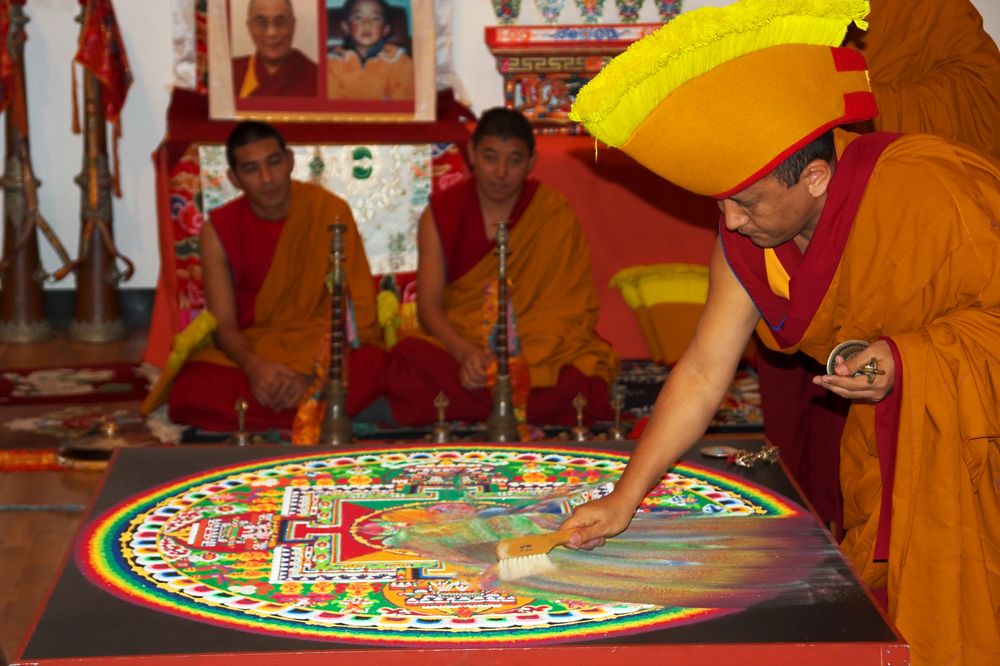Article
Sand Mandala and Reflections on Residency
Author(s):
Like residency, the Tibetan Buddhist tradition of Sand Mandalas requires teamwork to accomplish a common goal. The group effort by both Sand Mandalas and residents results in a transformative experience.
Sand Mandala destruction ceremony ©ArturBogacki-shutterstock

RESIDENTS CORNER
“Success is a journey, not a destination. The doing is often more important than the outcome,” said tennis player Arthur Ashe, Presidential Medal of Freedom Award recipient and one of the people featured in a motivational poster at my residency hospital.
We enter residency after having surmounted undergraduate, medical school, and Match Day. For the most part, our lives have been a series of milestones. Those hurdles lead us to practice what is arguably the most important profession, one of caring for a person’s health.
In psychiatry, not only do we get to care for others’ well-being but we also share in one’s deepest emotions and secrets. In residency, I wonder if the goal was not just to reach this milestone but to actually have been a psychiatrist all along.
Here I am, 4 years older, 4 years wiser, and 4 years into my journey. When thinking of an analogy for my experience of residency, I looked for a concept that emphasizes process over content, focuses on the moment and not the result, and one that has always existed, beautiful, like human relationships can be.
Sand Mandala is a Tibetan Buddhist tradition that spans centuries. During this process that lasts several days, monks create stunning circular art pieces (mandalas) out of colored sand. Once completed, the design is destroyed as part of the ritual to confirm the value of the process over the result. Similarly, our journey to graduation is a path that should not be mistaken for an end product but appreciated throughout its course.
The department of psychiatry at the University of California, San Diego School of Medicine (UCSD) is a unique amalgam of tremendous researchers, extremely ill patients, and outstandingly accomplished residents. The commitment to research, clinical care, and teaching tug at each other constantly.
Much needed research holds the key to our future, but it can also seem out of touch with the reality of everyday care. Dedicated clinicians juggle the need of managed care and endless documentation requirements, while desperately making time for a little teaching along the way. Finally, didactics serve to make sense of it all and help to keep us motivated in what we do. Under those varied pressures, it is not surprising that even at such a competent program, some may think of residency as an obstacle course without much purpose other than the elusive goal of completing it.
As I leave the academic nest, I wonder if I misunderstood residency along the way. I am about to begin a comfortable-and meaningful-job, as medical director for the local jail system, as well as a private practice focused on psychotherapy. My dreams of Ericksonian generativity are well on their way. Furthermore, an agreeable residency in psychiatry only solidified my Ericksonian intimacy. I wonder whether residency was something other than achieving some intangible privilege. Instead, perhaps the process itself embodied the goal all along.
The grueling hours of certain rotations forced me to confront my own fears and overcome discomfort. My endlessly imposing super-ego only made my failures and shortcomings harder to take. In particular, the suicide of one of my patients pushed my sense of self worth to its brink. Such experiences were, looking back, crucial in my development. My rigidity and idealism needed to be broken in order to accept myself as I am. This renewed appreciation for my imperfections allows me to care for patients in a much more human way.
Many challenges in residency became the greatest learning tools. I am not sure I would have grasped the true meaning of hard work had I not seen a therapy patient after a 14-hour night shift; understood the despair of psychiatric illness without witnessing a patient rescued from a suicide attempt in the emergency department (ED); or appreciated the amount of work that giants in our field exert had I not seen my mentors writing one grant after another.
Most importantly, residency gave me the opportunity to be a psychiatrist from the second day. On July 2, 2011, I saw 6 ED consultations. I staffed those patients with my attending over the phone when my senior resident was too busy. Despite my uneasiness, I became a psychiatrist with my own patients that day. From then on, I had already achieved my lifelong goal to care for a patient’s well-being, share in his deepest emotions, and listen to her secrets.
Since the beginning, I have had the chance to participate in the life of endless emergency and inpatient encounters. I have found a true love for connecting with patients at a deeper level that only individual psychotherapy permits. Since my second year of residency, not one week has passed without seeing a patient for individual therapy. Thinking that those interactions were training requirements would miss the point-that those relationships I created with patients were all I wanted and needed for a sense of self worth.
Once I realized that I had found some of my answers, I had the privilege of becoming chief resident of outpatient psychiatric services at UCSD, supervising an incredibly talented group of residents through their discovery of outpatient care. Over the year, I had the opportunity to watch them grow, struggle, and fight with and for their patients. But most importantly I saw and guided them through their journey in becoming psychiatrists. I am not sure that I got to show them all I wanted. However, I know that they realize how right Carl Rogers was when he reminded us the most important maxim of psychiatry: our most valuable tool is our relationship with our patients.
Like residency, Sand Mandalas require teamwork to accomplish a common goal. The group effort by both Sand Mandalas and residents results in a transformative and stunning experience. However, the Tibetan tradition also teaches us an important lesson about our role, our place, and the purpose of it all. Failing to recognize our residencies as necessary and at times difficult steps to board certification in psychiatry misses the point that actually allows us to grow into excellent psychiatrists. As Rogers suggested, “When I accept myself as I am, then I can change.”1
To upcoming interns, I wish you the chance to have an experience like the one I had and take advantage of the unique opportunity to be a part of the greatest of all professions. My only advice: do not wait for residency to be over to enjoy it. You’ve already made it.
Disclosures:
Dr Badre is the past outpatient Chief Resident of psychiatry in the department of psychiatry at the University of California, San Diego School of Medicine. He recently was named a Laughlin Fellow, as well as a Group for the Advancement of Psychiatry fellow for his dedication to the field of psychiatry. He has engaged in research on dementias, substance abuse in older adults, and more recently has been interested in the areas of teaching and systems of care. He is currently starting as Medical Director of Psychiatry at the San Diego County Jails as well as clinical volunteer faculty at UC San Diego.
References:
1. Rogers, Carl. On Becoming a Person: A Therapist’s View of Psychotherapy. London: Constable; 1961.





